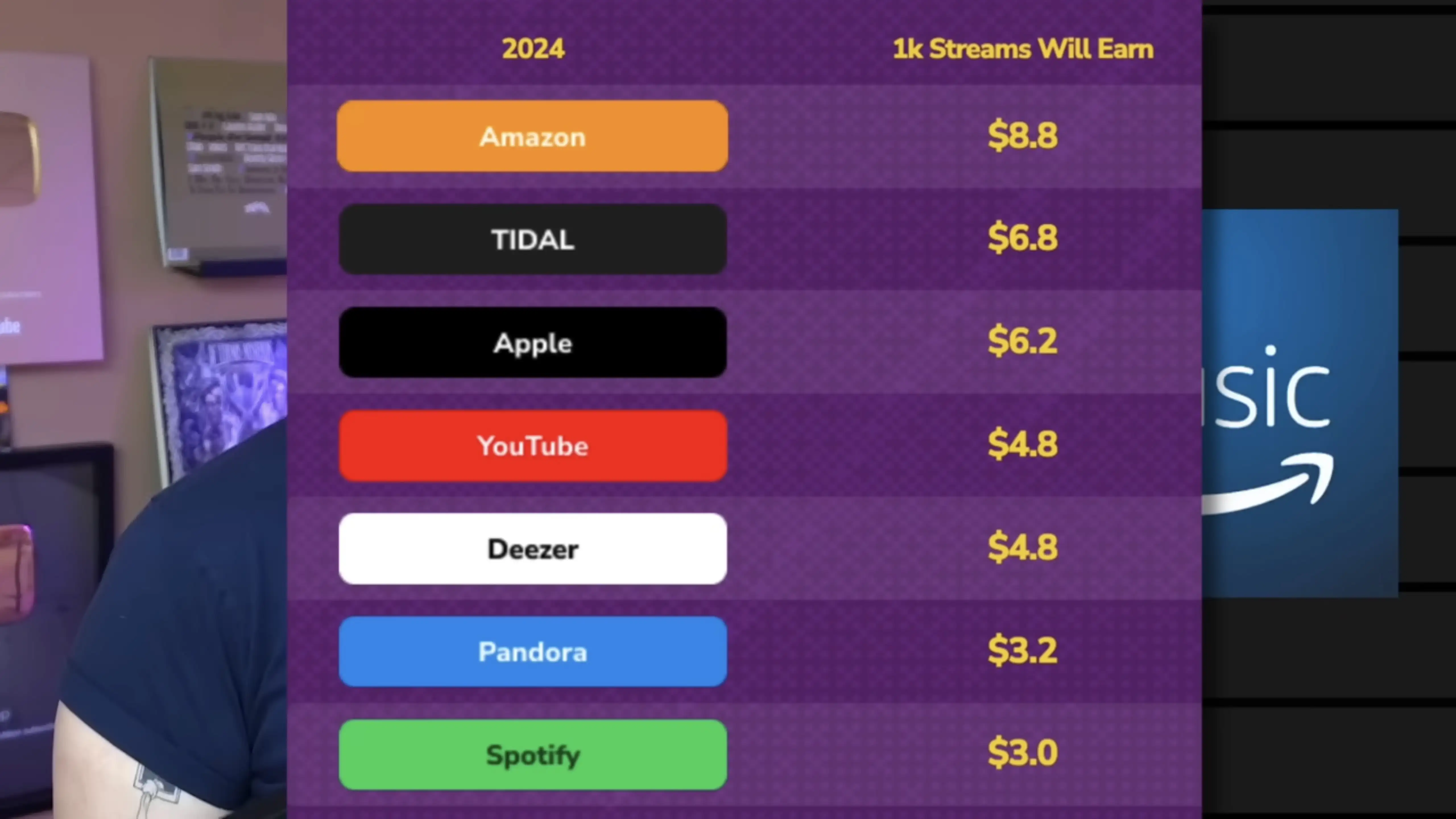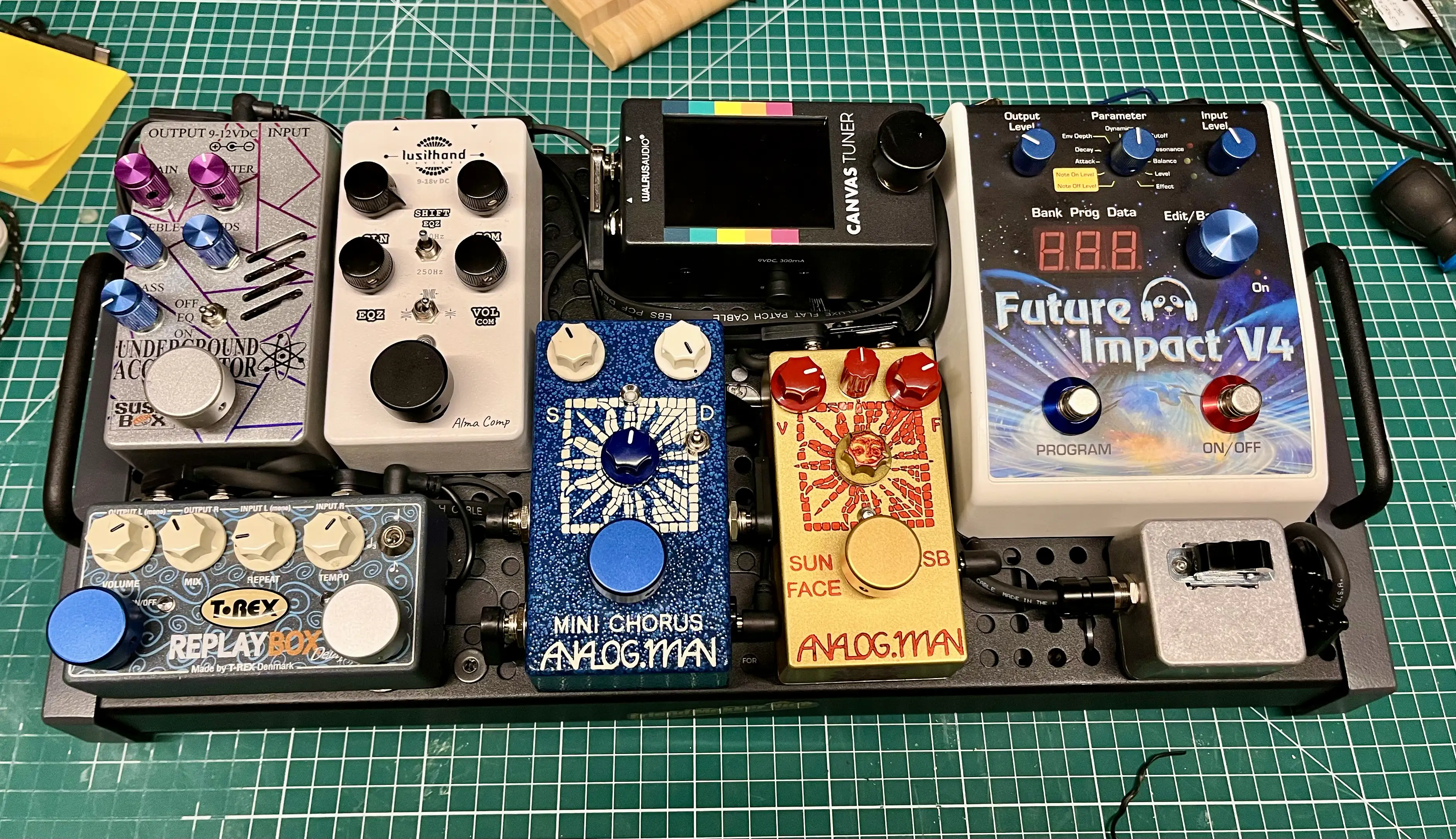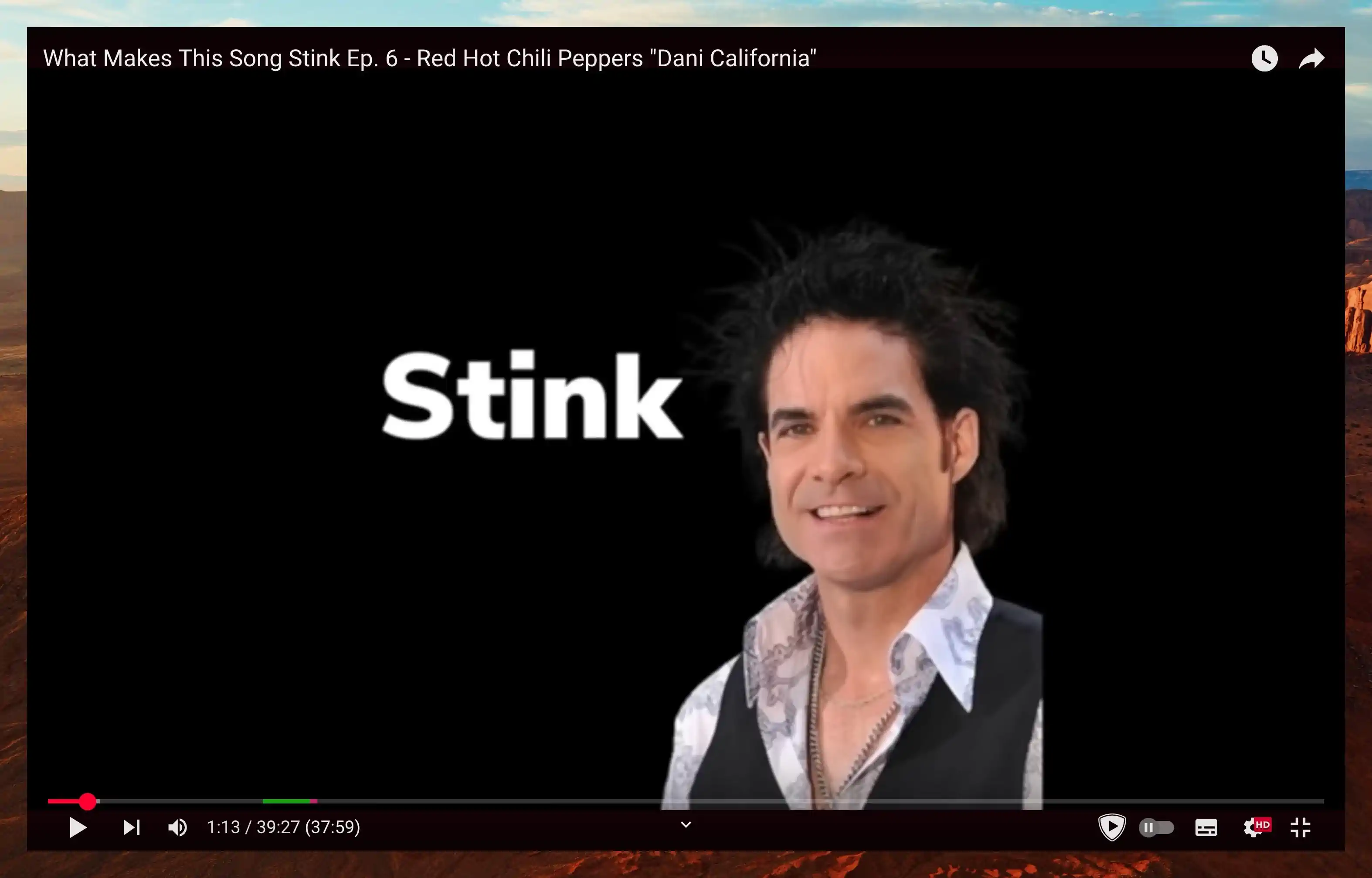Music
- They collect the revenue, and keep 30% of it.
- They then pay the rights holders 70%. Let’s call this the rights holders' share (RHS).
- They divide the RHS by grouping together all streaming on their platform — and if Taylor Swift had 1% of all streaming on the platform, she would get 1% of the RHS.
- How large is the RHS?
- How does the service balance increasing the revenue per customer and reaching more customers?
- How do they split the RHS among rights holders?
- What effect does the service have on artists, through AI, artist relations, etc.?
- And of course: Is the service owner someone you want to support or not?
- Guitar in
- Dry signal out
- Wet out L
- Wet out R
- … That Great October Sound (2001)
- Stray Dogs (2003)
- One Day You’ll Dance for Me, New York City (2004)
- Tidal: €11.64
- Apple Music: €7.25
- Spotify: €2.88
PLEASE Stop Evaluating Streaming Services Over How Much They Pay Per Stream
*Taps the Sign (Again)
Today I saw this video, that has a premise I really like: A tier list of different music streaming services, mostly based on ethics.
However, this reinvigorated my annoyance with the over-reliance on the payment per stream metric.
Check out my grand idea for music streaming here.
And also check out what I've written about streaming payment previously here.
The most straightforward reason for why this metric is useless is that that’s simply not how the deals with the music streaming companies work. At all. It’s not like there’s a set payment per stream (that’s lower on Spotify than Tidal), and if my band got streamed twice as much next month we’d earn twice as much.
Every streaming service I know of does just about what Spotify does:
I get that it’s a metric that makes sense to people. But that doesn’t beat out the fact that it doesn’t reflect the reality.
Here’s what I, both as a user and artist, want to know when evaluating services:
My Compact Stereo Bass Pedalboard
On the side, I do a bit of pedalboard building. And finally, I’m done with my own board — so I wanted to present it here! I’ll also go into all the pedals and why I chose them.
Board and I/O
The board itself is the smallest size made by Temple Audio.
On the right side of the board, I can plug in power for all the pedals and Input A and B. I play with two basses live: My 1961 Fender P-Bass and Fender Japan Fretless Jazz Bass — and having them both plugged in is nice.
The power supply is the Canvas Power 8 🖇️ from Walrus Audio, which I’ll show when I get to the underside of the board.
The left side has a USB-C charging port, forwarded from the Canvas supply, balanced stereo out (the two XLRs), and a jack output from the left channel.
«Wait, stereo for bass??»
I only have two stereo effects: Chorus and delay. But I think it’s really cool! Lately, my «sound» has gone on to always involve some saturation (usually fuzz and/or a cranked preamp) and chorus. Here’s a little taste of the sound (isolated bass), from a demo my band is working on.
So, that’s why I send a stereo signal (with the XLRs) to front-of-house. However, I’ll never bother with two amps — so that’s why there’s only one jack output. My DI does have the option to sum the left and right channel, but that doesn’t work with my chorus. So what I do is that I just send Left to the amp, and then asks for the Right channel in my monitor.
The signal chain
Quick Recommendation #3: What Makes This Song Stink (YouTube)
In general, I prefer positive content. So I prefer the vibe of CinemaWins over CinemaSins. But the series called What Makes This Song Stink, by Pat Finnerty, is an absolute treasure of YouTube content.
I think it can work for anyone – but it’s especially funny if you’ve spent any time on “Music YouTube”. (The series is packed with Rick Beato beats.)
I recommend starting at the beginning (of the playlist linked above), with Kryptonite by 3 Doors Down, and watch them in order. Then you’ll see the evolution of the form, and be in on all the terrific in-jokes. And already the third video, on Weezer - Beverly Hills, is a highlight.
It’s hard to explain, but the series just has so much heart, and Pat is just delightful. I highly recommend giving this series a try! (Also, he releases like a couple of videos a year – so its easy to stay on top of.)
Quick Recommendation #1: Cheap Strap Locks for Guitars
Why buy expensive (or just kind of cheap strap locks, when you can go old school and just order a bunch of rubber gaskets for bottles??
Here’s a link 🖇️ to the listing I used on AliExpress – but there are probably plenty of others that are just as fine. 👍🏻
I know it’s silly – but for some reason I think it’s a bit more rock ‘n’ roll to use something not meant for the purpose. 😎
"Julie", a New Single From My Band
I play bass in a band – and today we released a new single.
It’s called Julie, and I would love it if you gave it a whirl! 🫶🏻 It includes a modulation, an outrageous guitar solo, a fade-out, and good vibes.
I Got the Opportunity to Build My First Wet/Dry/Wet Guitar Pedalboard
I was lucky enough to be allowed to make this cool rig this week! It’s made to work well with one amp, but great with two. And if you’re a certified mad lad, you can even run it with three amps!
Allow me to explain:
When a signal has effects on it, it’s called “wet” – and when it doesn’t, it’s called “dry”. However, sometimes (like here), only some effects, like chorus, delay and reverb, are categorised as making the signal wet. And whether effects like overdrive and compression are on, the signal is categories as dry.
The board has four jacks in its side panel:
Rigs that have those three outputs are called wet/dry/wet rigs.
It's Not Too Late to Listen to the October Trilogy
Terrific Albums for the Autumn
For any Norwegians reading this, this recommendation will be categorised as very cliché. But clichés are just that for a reason – and if you haven’t listened to these albums, you’re in for a treat.
The albums I’m referring to, are the following, by the Norwegian artist Thomas Dybdahl:
They were all released in October, and are the perfect companions to wool jumpers, a fireplace, and warm soup. But I get that listening to three albums is a big ask. So as a taste, you can listen to his shortest song, which is also one of my favourites: Dice
The Story of My 1962 Bass Guitar
My Most Treasured Possession
In 2010, I went on a school trip from Norway to Los Angeles. I wanted a new bass, so I took a chance, and sold both basses I had at the time, to have funds to spend in L.A.
I was looking for a P-bass
But after not finding anything interesting in Guitar Center and other “regular” music stores, I searched online. There I found a store called Norman’s Rare Guitars. I didn’t know it at the time, but it’s one of the world’s most highly rated vintage shops – and they had a real bargain. You see, Fender instruments from the early 60s are expensive – especially the “Pre-CBS” ones.1 To put things into perspective: Norman’s have one currently, in great condition, which they want $10,900 for!
The one I ended up buying was even older, from 1962, but “only” $3,000. Not only that, the currency rate was much more favourable, from Norwegian Kroner, at the time. I paid what today would be $1,700.
Why it was so much cheaper
The guys as Norman’s said that the bass spent most of its life in the possession of a man they know who was. However, he wasn’t a stranger to experimenting with chemistry and his own blood – and the bass bears witness to this.
Here’s what I know about originality
I know that the volume pot is new (as I’ve swapped it myself) – and I don’t think the knobs are original.2 The rear strap button has been moved (to accommodate the heavy tuners). The headstock strap button is missing, alongside the pickup and bridge covers. However, as far as I know, the rest is original: Neck (more on this later), thumb rest, bridge tuners, pickup, and electronics.
As mentioned, my bass used to look like the one in the image above here – same finish and all.3 But now, and when I bought it, it looks like this:
Non-Reversible USB-C
What???
I’m a big proponent of the USB-C Lifestyle™️. All my chargers are USB-C, and so are my electric razor, dremel and screwdrivers. So I, of course, sneer at savages with their USB-A ports, where they have to guess which way is the correct one (and always choose the wrong one first, of course). But this summer, while helping some young family members with their pedalboards, I encountered something that shocked me to the core:
A USB-C usage where you had to put it in the right way for it to work. 🤯
Have We Been Evaluating Music Streaming Payments The Wrong Way?
One question that ofter comes up when discussing music streaming services, is: “How much are they paying artists per stream?" And there are many blog posts, like this one, that have tried to figure it out. It quotes some numbers, that I’ve seen several places, for Average Payout per 1000 Streams:
And this was the number that made me change from Spotify to Tidal last year — even though I don’t care about the increased audio quality, and I like Spotify’s app better. Comment sections are also often filled with things like “Spotify don’t pay artists”, etc.
But we might be thinking about it all wrong because here’s the thing: No1 streaming services actually pay per stream. Instead, all the major ones pile up the revenue, and then divide it to artists2 based on the percentage of total streams. So, even if I only listen to Blur, that doesn’t mean my payments only go to that artist.3
An interesting side effect of this is that, if every user streamed the same artists next month, but doubled their streaming amount, the payouts would be the same. But the blog posts above would have to halve the estimate for Payout per Stream.
So while it’s not totally irrelevant, I simply think payout per stream is the wrong number to look at. The more relevant number, is:
The percentage of revenue that goes to artists.
Allow me to explain:
Two (Ultra-Cheap) DI Boxes From China
One good, one terrible
Recently, I bought a couple of very cheap guitar pedals from China (through AliExpress). I’m working on making some pedalboards for some young family members, and I want to see how cheap I can get it without it being terrible.
My cousin plays the bass (like myself), so I would like to incorporate a DI box in his setup — so I ordered two different ones.
This Rowin DI (€20),
and this Dolamo DI (£16).
And the difference was huge!
Me: «Siri, define charisma.»
Siri: https://youtube.com/playlist?list=PLy2PCKGkKRVbpANcWiWA5X413SviHbNVi&si=b4SMATWviAtbF-dQ
(I’m specifically pointing to the first video. Giving the playlist because they’re all great, and to show that when asked to give his favourites, he starts with himself. 😎 Love it!)
The Prettiest Voice Since Allison Krauss
I’ve been thinking way too much about music streaming the past month - so now I’ve gathered my thoughts in a blog post!
I have an idea and dream, that I’m sadly woefully unequipped to actually build. 🙃
It’s a cross between podcasts, Mastodon, PeerTube and the MusicKit API!
🌱 An Idea For Better Music Streaming
I sadly don’t have the abilities to live out this idea — at least not alone. So everyone who finds this, is welcome to steal it or riff with me!
I’m currently trying to transfer from Spotify to Tidal. The main reason is that I want to use a service that pays artists better — and it’s a nice bonus that the sound quality is better. However, I prefer Spotify’s app and features. 1 And this inspired me to write out an idea I’ve been thinking about for a while.
Inspired by Mastodon, Apple’s MusicKit API, Podcasts and PeerTube
Third-party first
Pedal tuners and product design
Firstly, sorry about caring a bit too much about guitar tuners. You see, as a side gig, I help people with their pedalboards (especially people using multiple guitars on stage), and I often recommend that they get a new tuner. But no tuners are exactly like I want!
While this post is mostly hard core nerd out on pedal tuners, there are also some comments on product design in general. Let’s go!
A new product series gives (false) hope
I prefer always-on tuners that you mute elsewhere (volume pedal or otherwise), and this makes foot-switches redundant. That’s why I like the idea behind Boss TU3-S.
So, when I saw the new(ish) Korg X tuners, I was stoked – especially for the XS. The pedal to display size ratio is great, the switch design is cool, and I like that it’s more squared off than your typical mini pedal. This allows it to fit into odd slots on pedalboards.
Today in «Record I’d totally forgot, but that’s really good 🎵»:
Fountains of Wayne - Welcome Interstate Managers
(Spotify - Apple Music)
#Allheimen


























